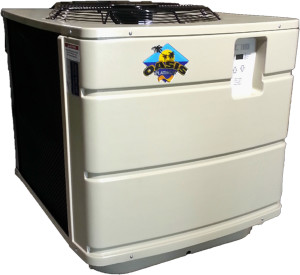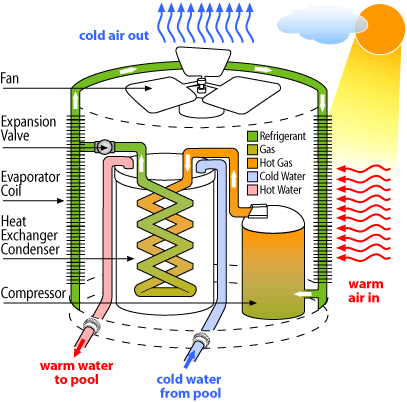If you’re tuned into the world of pool heating, then you’ve likely heard some buzz about air-source pool heat pumps before. They are just one of the many types of pool heaters available to consumers – but you’re probably wondering what makes them different from other pool heaters, and more so, what exactly “air-source” is.
First, let’s answer an essential question.
What is a pool heat pump?
A heat pump pool heater is a machine that uses a reversible high-pressure refrigerant system to heat or cool water. The refrigerant combines with warm air drawn in from the atmosphere to produce heat.
How do I know if I have an air-source pool heat pump?



Sometimes, figuring out what type of pool heater you have is a little confusing. Nearly all pool heaters share a similar look as far as size, shape, and color is concerned. (Trying to figure out what size pool heater you need? Check out the pool heat pump sizing calculator section in this post)
That being said, here are some defining features to look for.
ALL air source pool heat pumps use:
- A fan (located on the top of the unit)
- Evaporator coil
- Dedicated electrical line
What is “Air-Source” heating | How do air-source pool heat pumps work?
“Air-source” implies that a heater sources its heat from the air in the environment. The heat transfer process takes advantage of heat’s natural ability to move from a high-temperature area to a lower one. Using a small amount of energy, air source pool heat pumps use a fan to harvest heat, and later distribute that heat into your pool water. The main components involved in the heat transfer process are the fan, evaporator coil, compressor and heat exchanger.
Here’s a detailed explanation to give you a better idea:
The process starts when the fan draws in warm air from the environment and passes it through an evaporator coil. From there, the liquid refrigerant within the evaporator coil reacts with the air and forms a warm gas. The compressor then pressurizes the warm gas into a hot gas, and pumps it through a titanium tube located within the heat exchanger . This is actual heat transferring takes place.
At this point, the water from your pool flows through the heat exchanger and passes over the heated titanium tube. Two things happen during this exchange. The hot tube disperses its heat into the flowing water — at the same time, the water helps cool down the hot titanium tube, preventing it from overheating. Finally, the heated water is pumped back into the pool, and you enjoy the comfort of a refreshingly warm swim.
(On a side note: A reversing valve located near the compressor controls the direction of the refrigerant flow, which aids in both cooling and defrosting coils during colder temperatures.)
If that was all just a bit too much to take in, simply imagine an air conditioner but in reverse.
What makes Air-Source Pool Heat Pumps different from other pool heaters
Although all pool heaters have their pros and cons, let’s focus on the core concepts behind each type and how they differ from air-source pool heat pumps.
- Electric Resistance Pool Heaters – apply electricity to a resistor to produce heat
- Solar Pool Heaters – incorporate solar panels which absorb the heat from the sun (typically installed on a roof) to heat water.
- Gas Pool Heaters – uses gas-powered combustion to quickly heat up water [Learn more: Pool heat pump vs Gas heater]
Want to better understand the differences between the pool heater types?
This post will help you choose the best pool heater for you
Why “Air-Source” Heat Pumps?
Air Source Heat Pump COP
Air-source pool heat pumps heat your pool using a minimal amount of energy (up to 7 times less than gas heaters). In pool heating, this is referred to as a Coefficient of Performance.
The average pool heat pump COP sits at about 6.0, producing 6 units of energy for every dollar spent, which is good.
That’s just a quick rundown of how pool heat pump COPs work – to learn more, check out our article on Coefficient of Performance.
Eco-Friendly Pool Heating
It may surprise you to know that air-source pool heat pumps are among one of the most eco-friendly options. They use a minimal amount of resources to do the job with low electricity use, and zero harmful emissions.
It may also please you to know that quality air-source heat pumps, with good pool heat pump maintenance, require very few repairs throughout their lifetime. All in all, air-source heat pumps are one of the most cost-effective and environmentally friendly pool heating solutions you can choose.
Are you a new pool owner with a few questions? Our Pool Owner Guide is your go-to resource
Considering an air-source heat pump for your pool? Talk to a pool heating specialist today.
SOURCES: Energy.Gov | GulfStream |HowStuffWorks




